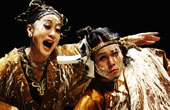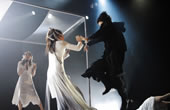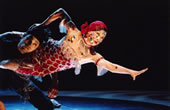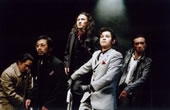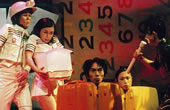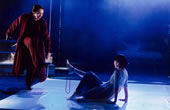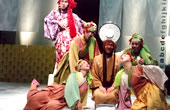Yojo-han: Japanese traditional theatre, such as no and kabuki, has cherished the beauties for restrained body movements and vocalization that peculiarly stresses the pronunciation of vowels. In an effort to create an original acting style that reflects the realities of the stressful life or contemporary Japanese instead of so-called realism acting based on the life of nineteenth-century bourgeois in Europe and thus not felt as real in the eyes of the middle-class Japanese of today, the director Masahiro Yasuda radically deconstructs the conditions that characterized the acting styles of Japanese traditional theatre and confines the movements of actors to the space of a typical Japanese tearoom size, yojo-han. Yojo-han means four and half straw(“tatami”)floor mats(“jo”), approximately occupying the area of as little as 8 square meters. When the sixteenth-century legendary tea master Rikyu designed tearooms, he decided that the size of yojo-han was large enough for people to attend tea ceremonies since they should not bring any personal belongings in so they would emancipate themselves from their everyday affairs. But ironically, from the seventeenth century through the 1970s, it also became the standard living room size for average Japanese town people, and is still now associated with tiny little houses seen everywhere in Japanese cities. Based on his unique theory that yojo-han physically defines the movements of the Japanese and symbolizes a sense of constraint that many of them feel when they are caught in the middle between duty and desire (classically expressed as the opposition between giri and ninjo in kabuki plays), as well as s state of highly concentrated mind required of participants in tea ceremonies, Yasuda set up several "rules" that actors should observe as they perform: while standing still, pull away from the center of gravitation in your body; while moving, imagine as if you were going along a narrow path; when spoken to by another actor, freeze on the spot and listen to his/her lines attentively; when no one speaks to you, continue your movement in a slow motion. By imposing these restrictions on the movements of actors, they can express how modern Japanese people sensitively and even neurotically react to their surroundings and other people.
|
|||||||||||||||

